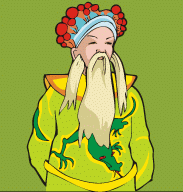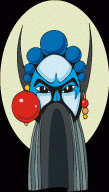China's Dynasties
The Chinese were ruled by various dynasties.
A dynasty is a time period that is ruled by a specific family.
When a new dynasty was to come into power it would overthrow the existing dynasty.
Chinese civilization, as described in mythology, begins with
Pangu - sometimes spelled Bangu - the creator of the universe, and a succession
of legendary sage-emperors and culture heroes (among them are Huang Di , Yao, and Shun)
who taught the ancient Chinese to communicate and to find sustenance, clothing,
and shelter.
--------------------------------------------------------------------------------
XIA DYNASTY: 2000 - 1500 BC
The first dynasty is said to be Xia, from about the twenty-first to the sixteenth
century B.C. Until excavations were made at early bronze-age sites at
Anyang , Henan Province, in 1928, it was difficult to separate myth from reality in regard
to the Xia. But since then, and especially in the 1960s and 1970s, archaeologists have
uncovered urban sites, bronze implements, and tombs that point to the existence of Xia
civilization in the same locations cited in ancient Chinese historical texts.
--------------------------------------------------------------------------------
SHANG DYNASTY: 1700 - 1027 BC
Thousands of archaeological finds in the Huang He, Henan Valley - the apparent
cradle of Chinese civilization--provide evidence about the Shang dynasty, which lasted
from 1700 to 1027 B.C. The Shang dynasty (also called the Yin dynasty in its later
stages) is believed to have been founded by a rebel leader who overthrew the last Xia ruler.
Its civilization was based on agriculture, hunting and animal husbandry.
Two important events of the period were the development of a writing system, as revealed
in Chinese inscriptions found on tortoise shells and flat cattle bones
, and the use of bronze. A lot of ceremonial bronze
vessels with inscriptions date from the Shang period; the workmanship on the bronzes
attests to a high level of civilization.
--------------------------------------------------------------------------------
THE ZHOU DYNASTY: 770- 221 BC
The Zhou dynasty lasted longer than any other.
n 771 B.C. the Zhou court was sacked, and its king was killed by invading barbarians who
were allied with rebel lords
. The capital was moved eastward to Luoyang in present-day Henan Province. Because of this
shift, historians divide the Zhou era into Western Zhou (1027-771 B.C.) and Eastern Zhou
(770-221 B.C.). With the royal line broken, the power of the Zhou court gradually diminished;
the fragmentation of the kingdom accelerated. Eastern Zhou divides into two subperiods.
The first, from 770 to 476 B.C., is called the Spring and Autumn Period, after a famous
historical chronicle of the time; the second is known as the Warring States Period
(475-221 B.C. ).
--------------------------------------------------------------------------------
QIN DYNASTY: 221-207
This dynasty was vigorous but short-lived. Much of what came to constitute China Proper was
unified for the first time in 221 B.C. In that year the western frontier state of Qin, the most
aggressive of the Warring States, subjugated the last of its rival states. Once the king of Qin
consolidated his power, he took the title Shi Huangdi ( First Emperor), a formulation
previously reserved for deities and the mythological sage-emperors, and imposed Qin's
centralized, nonhereditary bureaucratic system on his new empire.
To fend
off barbarian intrusion, the fortification walls built by the various warring states were
connected to make a 5,000-kilometer-long great wall.
What is commonly referred to as the Great Wall is actually four great walls rebuilt or
extended during the Western Han, Sui, Jin, and Ming periods, rather than a single,
continuous wall. At its extremities, the Great Wall reaches from northeastern
Heilongjiang Province to northwestern Gansu.
--------------------------------------------------------------------------------
THE THREE HAN DYNASTIES: 206 BC- 220 AD
After a short civil war, a new dynasty, called Han emerged with its capital at Chang'an.
. A civil service examination system also was initiated. Intellectual, literary, and artistic
endeavors revived and flourished. The Han period produced China's most famous historian,
Sima Qian ( 145-87 B.C.?), whose Shiji (Historical Records) provides a detailed chronicle
from the time of a legendary Xia emperor to that of the Han emperor Wu Di (141-87 B.C.).
Technological advances also marked this period. Two of the great Chinese inventions,
paper and porcelain, date from Han times. After 200 years, Han rule was interrupted briefly
(in A.D. 9-24 by Wang Mang, a reformer),
and then restored for another 200 years. The Han rulers, however, were unable to adjust to
what centralization had wrought: a growing population, increasing wealth and resultant
financial difficulties and rivalries, and ever-more complex political institutions. Riddled
with the corruption characteristic of the dynastic cycle, by A.D. 220 the Han empire
collapsed.
A.D. 220-280: Three Kingdoms
220-265 -- Wei
221-263 -- Shu
229-280 -- Wu
A.D. 265-316: Western Jin
A.D. 317-420: Eastern Jin
A.D. 420-588: 420-478 -- Song - 479-501 -- Qi - 502-556 -- Liang - 557-588 -- Che - 386-533 -- Northern Wei - 534-549 -- Eastern Wei - 535-557 -- Western Wei - 550-577 -- Northern Qi - 557-588 -- Northern Zhou
--------------------------------------------------------------------------------
SUI DYNASTY: 589-617 AD
The decline and fall of the Later Han dynasty produced a long period of independent
states each contending for hegemony over neighboring states; this period, in fact, lasted so
long that the more or less uniform Chinese culture almost died out completely. Starting in
384 AD, however, the Northern Wei kingdom began the long, arduous process of reuniting
the kingdoms into a single empire.
Neo-Taoism, which was called "the mysterious learning" in early China, had grown during the
waning years of the Later Han, had both a scholarly and a popular form.
Buddhism entered China in the first century AD; an Indian religion that was initially a radical
form of Hinduism, the dominant religion in ancient India, it was accepted with open arms in
China. This is largely due to the fact that the early Chinese initially thought that Buddhism was another form of Taoism, particularly since the translators used Taoist terms to translate Buddhist doctrines. The early Chinese, in fact, believed that Lao Tzu had travelled to India and that the Buddha was his disciple. Despite this, Buddhism never really took off during the Later Han period. However, when the Han government collapsed and China fell into chaos, Buddhism caught fire all over the former empire, primarily among the common population. Like folk Neo-Taoism, it offered salvation and was a moral religion. By the time of the rise of the Northern Wei in 384, Buddhism had spread over the whole of China. Although Buddhists were occasionally persecuted, on the whole they were tolerated. Some emperors even converted to Buddhism.
--------------------------------------------------------------------------------
TANG DYNASTY: 618-907 AD
The Tang dynasty (A.D. 618-907), with its capital at Chang'an, is regarded by historians
as a high point in Chinese civilization--equal, or even superior, to the Han period. Its territory
, acquired through the military exploits of its early rulers, was greater than that of the Han.
Stimulated by contact with India and the Middle East, the empire saw a flowering of creativity
in many fields. Buddhism, originating in India around the time of Confucius, flourished
during the Tang period, becoming thoroughly sinicized and a permanent part of Chinese
traditiona
l culture.
Block printing was invented, making the written word available to vastly greater audiences.
The Tang period was the golden age of literature and art. A government system supported
by a large class of Confucian literati selected through civil service examinations was
perfected under Tang rule.
By the middle of the eighth century A.D., Tang power had ebbed. Domestic economic
instability and military defeat in 751 by Arabs at Talas, in Central Asia, marked the beginning
of five centuries of steady military decline for the Chinese empire. Misrule, court intrigues,
economic exploitation, and popular rebellions weakened the empire, making it possible for
northern invaders to terminate the dynasty in 907. The next half-century saw the
fragmentation.
--------------------------------------------------------------------------------
SUNG DYNASTY: 960 AD
Founder of the Sung Dynasty
In 960 the Sung Dynasty had begun. A military leader,
Chao K'uang Yin seized power and proclaimed the Sung Dynasty. Within a few years he and
his officials had restored peace. The Sung were wiser than the other dynasties because they
knew how the other dynasties had fallen when the governors became too powerful. Instead
they did not split up the land into sections. China was under the emperors hands only.
They re-established Confucianism as the master philosophy and . reunified most of China
Proper.
The Sung period divides into two phases: Northern Song (960-1127) and Southern Song
(1127-1279). The division was caused by the forced abandonment of north China in 1127
by the Song court, which could not push back the nomadic invaders.
While the Sung was successful, events in distant lands showed the end and destruction of the
dynasty.
In 1206 an assembly of Mongolian tribes at Karakorum and they agreed to unite unde
r Genghis Khan. The Mongol leader Genghis Khan was one of the great conquerors in
the history of the world. He was the son of Yesugei, leader of a small tribe in northeastern
Mongolia. Yesugei was poisoned when Temujin (Genghis Khan's name as a youth) was
about 10 years old, and the orphaned boy later entered the service of Toghril Khan, the
most powerful Mongol ruler of the time. In 1215 Genghis Khan captured Beijing in 1279.
Kublai Khan, his grandson, completed what they called The Quest of China and then he
ended the Sung Dynasty.
Kublai Khan
--------------------------------------------------------------------------------
LIAO DYNASTY: A.D. 916-1125
For 300 years, China was divided by several competing dynasties and kingdoms. One
of these was Liao, a powerful kingdom established by the Qidan, who came from the north
beyond the Great Wall. Even though their dynasty ruled most of northern China, the Qidan
kept many of their own customs, which were strange to the Chinese of the south. One of these
was to mummify their dead, a practice that the Chinese considered barbaric; however, it was
the Liao way of preserving the body as a sanctuary for the spirit.
--------------------------------------------------------------------------------
WESTERN XIA: A.D. 1038-1227
--------------------------------------------------------------------------------
JIN: A.D. 1115-1234
Gilt Bronze Warrior
--------------------------------------------------------------------------------
YUAN: A.D. 1279-1368
The Yuan Dynasty had now begun. Despite their initial success, the Mongols had lost their
power rapidly in the 14th century. They lost power because they did not adopt the Chinese
language and customs from the earlier dynasties. Heavy taxes were raised and it lead to
peasantry. During this time a widespread famine was going on and floods were almost
everywhere in China. Soon there were revolts in every province of China. In the Yangtze
Valley, Chu Yu-chang, a former Buddhist monk had turned to become a rebel leader
. He led a peasant army to power in the 1360's. He was the founder of a new dynasty -the
Ming.
--------------------------------------------------------------------------------
MING: A.D. 1368-1644
Yu-chang founded the Ming Dynasty in 1368 and in 1371 he drove the Mongols out o
Beijing. After more than a century of ruling the Mongolians retreated to the Mongolian heartland. They had continued to harass their Chinese neighbors, but could never again conquer the Chinese nation. The Mings were less inventive than the past dynasties because this was a trading period between the European neighbors.
This became a trading period because in the 18th century China's trading business
expanded almost all over the world. In this period it is called "restoration and
reorganization." Many non-Chinese states were forced to know the power of China,
and was forced to pay tribute. Later, the Ming dynasty was weakened and the treasury was
low because it was used up by defending their borders. A rebellion broke out in the Shanxxi
province that was brought to a famine. After the rebels took Beijing the Ming formed a
union with the Manchus who had recently gained power over Manchuria. Once inside
China the Manchus refused to leave. Rebellions broke out and that was the end of the
dynasty. The rebels forced the last emperor to commit suicide.
--------------------------------------------------------------------------------
QING OR MANCHU DYNASTY: A.D. 1644-1911
The Manchus had reached their power in the 18th century when they controlled Manchuria,
Mongolia, and Tibet. Also Chinese influence had reached Nepal, Burma, Korea, and
Vietnam. Later, China as weakened by the Taiping Rebellion in 1850-1864, led by
Hung Hsiu-ch'uan, an unsuccessful leader who failed the Confucian exam four times.
A Confucian exam is an exam that you take to become an official in the military or a judge.
The rebellion was the most deadly in Chinese History. During the last decades of the 19th
century foreign governments gained control over parts of China. In the Boxer Rebellion, the
Chinese nation tried to drive out the Europeans and the Americans, but they were defeated.
The Manchu Government was weak enough for the revolutionary leader Dr. Sun Yat-Sen.
he succeeded in toppling the Manchu dynasty and the last Chinese Dynasty.
--------------------------------------------------------------------------------
Republic of China (in mainland China): A.D. 1911-1949
The republic that Sun Yat-sen and his associates envisioned evolved slowly. Sun Yat-sen
died of cancer in Beijing in March 1925, but the Nationalist movement he had helped to
initiate was gaining momentum.
Sun Yat-sen
--------------------------------------------------------------------------------
Republic of China (in Taiwan): A.D. 1949-
--------------------------------------------------------------------------------
People's Republic of China: A.D. 1949-
On October 1, 1949, the People's Republic of China was formally established, with its
national capital at Beijing, with Chairman Mao Zedong.
,
and the national capatalists



back to my home page